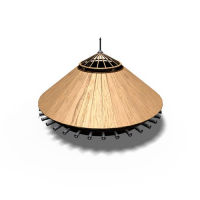Remaking Nature Click on the thumbnails to explore the trail
Read more about this trail (expand)
Leonardo’s ultimate aim was to imitate nature by remaking nature, as opposed to slavishly copying natural forms. This would require a profound understanding of the relationship between the effects of natural appearances and the underlying causes that gave rise to their form. Equipped with this knowledge, Leonardo believed he could create forms equitable to those found in nature, many of which might be of great service to man.

- Enlarge
- © Leonardo3 - www.leonardo3.net
Armoured car - Biblioteca Reale, Fol 1030 1485
In a letter to Ludovico Sforza, Leonardo described ingenious machines of war to entice his potential patron into giving him employment. Although the machines were highly innovative they were mainly unworkable fantasies, based on ideas from the classical world.
This tortoise-shaped armoured vehicle looks like an early forerunner of the modern tank. In the drawing, Leonardo emphasised the machine’s “anatomy”, illustrating the mechanisms by which it operated. The exterior was reinforced with metal plates and a turret armed with guns was contained within its interior. Inside, eight men would turn cranks to move the wheels. The tank would then scuttle across the battle-field, dispensing a hail of shot from around its rim. The element of surprise would have been crucial - the sudden appearance of the vehicle on the battlefield would surely have stunned the enemy!
Realising that the force required to move the machine would have exceeded the physical power of eight men, Leonardo thought of replacing the men with horses or oxen. The idea was rejected on the basis that the animals were likely to become agitated in such a restricted and noisy environment.
In Leonardo's words
…I will make covered vehicles, safe and unassailable, which will penetrate the enemy and their artillery, and there is no host of armed men so great that they would not break through it. And behind these the infantry will be able to follow, quite uninjured and unimpeded…
From Leonardo’s letter to Ludovico Sforza, c1481-82
Leonardo probably drew this model of a war machine for a presentation to Ludovico il Moro, “The Moor”, Duke of Milan, around 1485. The drawing in the original manuscript therefore appears neat and well laid-out.
The armoured car, like other inventions such as the scythed chariot, has a classical pedigree. Like other Renaissance artist-engineers, Leonardo looked to the classical world for inspiration. He would then go beyond classical models and devise his own solutions.
Leonardo’s armoured car contained many light cannons. These were arranged on a circular platform which was based on four wheels and provided a firing range of 360 degrees. The whole platform was surrounded by a conical cover with a sighting turret at the top. At the centre of the car, two cranks were used to set the machine in motion.
The project is technically unrealisable and the drawing also contains a mechanical error which prevents the car from functioning – the cams as drawn would turn the wheels in opposing directions. But this is a demonstration piece, not a working drawing for technicians.
Many consider this armoured car as the precursor to the modern tank.
- Location Biblioteca Reale










